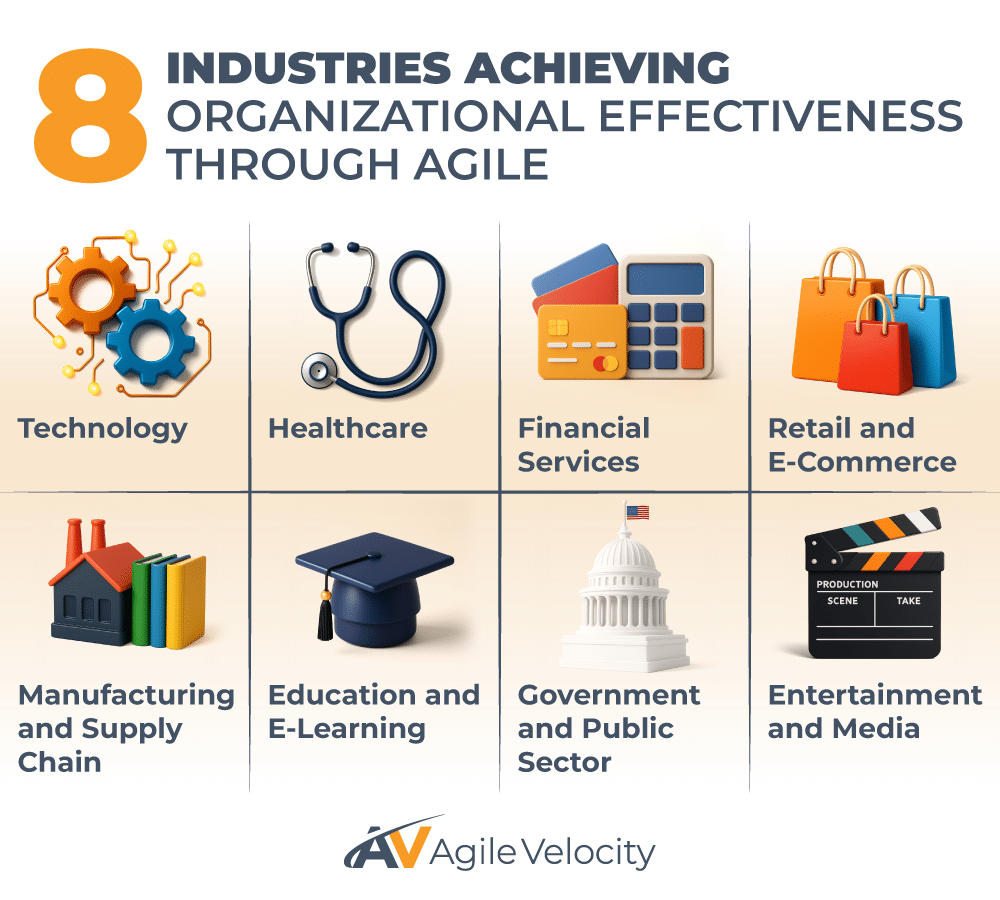Agile transforms organizational effectiveness by fostering flexibility, speeding up value delivery, and enhancing team collaboration. Industries are shifting from rigid practices to Agile’s iterative, results-focused approach. In this article, we explore eight sectors that excel with Agile and offer actionable insights for CEOs, Project Managers, and Agile practitioners.
1. Technology Industry: Staying Ahead with Agility
Technology companies rely on Agile practices to keep pace in a fast-moving market. Using frameworks like Scrum and SAFe®, teams work in short sprints to continuously refine products. The Scrum Masters help teams stay on track by removing obstacles while the Product Owners continuously adjust the Product Backlog based on evolving customer needs
Breaking Work Into Manageable Sprints
Agile sprints focus on clear, short-term goals that cumulatively build toward larger objectives. This cadence enables flexibility and responsiveness, essential in the rapidly changing tech landscape.
Scaling Agility with SAFe®
SAFe® supports technology organizations by integrating multiple teams into a unified Agile Release Train, a coordinated set of Agile teams that deliver value on a common cadence, while Lean Portfolio Management aids in prioritizing initiatives and balancing innovation with timely delivery.
Real-World Outcomes
Agile practices in technology have been shown to accelerate delivery timelines, enhance customer satisfaction, and drive strategic alignment—empowering teams to innovate and respond rapidly to market needs.
2. Healthcare Sector: Embracing Agility for Patient-Centered Solutions

In healthcare, organizational effectiveness improves patient outcomes by streamlining operations and fostering rapid innovation. Breaking down silos enables faster, more responsive patient care while meeting evolving compliance requirements.
Managing Complexity with Agile
Healthcare workflows benefit from breaking down complex processes into manageable iterations. Regular review sessions ensure that clinician and regulatory feedback are integrated into ongoing improvements.
Crisis Preparedness and Responsiveness
Under high-pressure conditions, such as public health emergencies, Agile teams in healthcare have shown an enhanced ability to deliver timely solutions through iterative problem-solving and continuous feedback.
Practical Applications
Agile accelerates the development of medical devices, improves operational efficiency using Kanban boards and Work In Progress (WIP) limits, and enables rapid adaptation to evolving policies—ultimately supporting better patient care.
3. Financial Services: Balancing Speed, Compliance, and Innovation
Financial institutions operate in highly regulated environments where rapid innovation must align with strict compliance requirements. Agile provides a framework that supports faster feature development enables teams to manage risk and regulatory demands.
Lean Portfolio Management for Smarter Decisions
Implementing Lean Portfolio Management allows financial organizations to balance initiatives such as online banking enhancements against risk management and resource allocation.
Enhancing Transparency and Managing Risk
Short iterations and daily scrum meetings encourage proactive identification and resolution of compliance issues, thereby facilitating better risk management and increased operational transparency.
Measurable Benefits
Agile can contribute to shorter time-to-market for new features, improved risk management protocols, and higher levels of customer engagement through regular, iterative improvements.
4. Retail and E-Commerce: Thriving Amid Evolving Consumer Demands
Retail and e-commerce sectors must rapidly respond to shifting consumer behavior. Agile practices enable quick updates to digital platforms, optimized customer experiences, and improved supply chain responsiveness.
Iterative Feature Deployment
Scrum-based teams deliver updates in short sprints—testing and refining features such as shopping carts and personalized recommendations—to ensure that digital platforms evolve with customer needs.
Building Resilient Supply Chains
By utilizing Kanban boards and Work In Progress (WIP) limits, retail teams can maintain clear oversight of workflows and quickly adjust operations during periods of high demand or disruption.
Practical Benefits
Agile drives continuous innovation, customer-centric enhancements, and integrated omnichannel experiences that maintain competitiveness and responsiveness.
5. Manufacturing and Supply Chain: Achieving Agility Through Resilience

Manufacturing and supply chain industries are transitioning from rigid, linear processes to adaptive frameworks that reduce waste and enhance efficiency.
Transitioning to Agile Workflows
Agile methods decompose complex production processes into incremental steps, with regular sprint planning and retrospectives that allow early identification and correction of inefficiencies.
Enhancing Supply Chain Resilience
Visual management systems and defined WIP limits empower teams to predict and address bottlenecks, thus maintaining quality and timely delivery standards.
Tangible Results
Manufacturers have reported reductions in waste, improvements in quality assurance, and heightened supply chain resilience that contribute to overall operational stability.
6. Education and E-Learning: Meeting Modern Learner Demands
Educational institutions and e-learning platforms use Agile principles to respond to changing learner needs and enhance engagement.
Incremental Course Development
Educators break down course material into modular units, iteratively updating content based on direct student feedback to maintain relevance and engagement.
AI-Driven Personalized Learning
By integrating AI solutions, e-learning platforms can tailor content to individual student needs, promoting adaptive and efficient learning pathways.
Measurable Improvements
Agile methodologies support rapid curriculum updates, personalized learning experiences, and scalable online platforms that meet evolving educational demands.
7. Government and Public Sector: Enhancing Service Delivery and Accountability

Government agencies are adopting Agile to overcome bureaucratic constraints and improve service delivery for citizens. Regular iterations and cross-departmental collaboration help streamline processes and incorporate stakeholder feedback.
Breaking Down Bureaucracy
Agile transforms traditionally siloed government departments into fluid teams that focus on delivering prioritized services. Frequent iteration reviews allow for real-time adjustments while ensuring processes remain transparent.
Enhancing Transparency and Responsiveness
Lean Portfolio Management and Agile practices in government settings have helped accelerate service delivery and improve citizen satisfaction through continuous feedback loops. It is important to note that while accelerated delivery and improved user satisfaction are documented benefits, the impact on fiscal responsibility and overall public trust can vary with implementation and context.
Strengthening Public Trust
Agile methodologies can contribute to faster service delivery and potentially elevate user satisfaction. However, claims regarding enhanced fiscal responsibility and increased public trust depend on how effectively the transformation is implemented.
8. Entertainment and Media: Where Creativity Meets Agility
In the fast-paced world of entertainment and media, Agile supports rapid content production while maintaining creative excellence and audience engagement
Streamlining Content Creation
Large-scale projects—such as film production or game development—are broken into smaller, manageable increments. Short sprints allow creative teams to gather audience feedback and refine content throughout the project lifecycle.
Enhancing Team Coordination
Organizational effectiveness facilitates synchronization among diverse groups—writers, editors, developers—ensuring that creative projects remain on track even under tight deadlines. AI solutions help automate repetitive tasks so teams can focus on innovation.
Impactful Results
Adopting Agile can lead to faster content release cycles, improved creative processes, and balanced workloads across creative teams, thus supporting high-quality production outcomes.
Innovations Driving Further Agile Transformation
Agile is evolving rapidly to meet the demands of a technology driven future. As technological advancements accelerate, organizations may increasingly integrate sophisticated AI tools and automation systems into their Agile practices to further streamline workflows. Although such trends are evident across various sectors, the specific benefits will vary based on context and implementation details.
Key Strategies for Successful Agile Adoption
Successful Agile adoption goes beyond mere process change—it requires a cultural shift. Key strategies include:
Fostering Agile Mindsets
Agile Coaching helps teams internalize agile principles and adapt to new roles, ensuring that continuous learning becomes a core value.
Securing Leadership Alignment
Leadership must champion Agile by setting clear visions, aligning objectives, and allocating necessary resources to support transformation throughout the organization.
Building the Right Ecosystem
A robust Agile Transformation depends on cross-functional teams, continuous training, and strategic staffing—creating a sustainable foundation for iterative improvement.
Navigating Challenges and Ensuring Sustainable Organizational Effectiveness
While Agile’s benefits are well recognized, organizations may face challenges during transformation. Resistance to change, inconsistent practices across teams, and varying interpretations of Agile principles can hinder progress. Addressing these challenges requires clear communication, dedicated coaching, and small pilot projects that allow teams to experience early successes.
In addition, maintaining consistency amid diverse team implementations often requires comprehensive training and effective use of monitoring tools such as the Path to Agility Navigator, which provides real-time insights and benchmarks to guide process improvements.
Sustainability also depends on integrating Agile with other organizational practices such as lean operations and data-driven decision-making, ensuring that continuous improvement is embedded throughout the organization.
Future Outlook for Agile in Achieving Organizational Effectiveness
Looking ahead, trends indicate that Agile will continue to evolve and adapt to new technological possibilities. As organizations face accelerating technological changes, many are expected to integrate advanced AI tools and automation systems to further enhance workflow efficiency. However, while these trends suggest a transformative potential, the degree of impact will vary based on factors such as execution quality and organizational context.
Moreover, as remote and hybrid work environments become more common, Agile practices are evolving to support distributed teams through enhanced collaboration tools and asynchronous communication methods, ensuring that distance does not hinder iterative progress.
The future of Agile remains promising due to its inherent flexibility and commitment to continuous improvement. By investing in sustainable Agile Transformations, organizations can achieve not only operational efficiencies but also a competitive advantage in rapidly changing markets.
Benefits of Agile: A Common Thread
Agile practices have become an integral strategy for many organizations across varied industries, owing to its adaptability and focus on results-driven performance. By embedding Agile methodologies into their operations, businesses can transform how they manage projects, collaborate in teams, and respond to market demands.
Key Benefits of Agile:
- Accelerated Delivery: Agile emphasizes short, iterative sprints that facilitate quick deployment of new features, allowing businesses to bring products to market faster.
- Enhanced Collaboration: By breaking down traditional silos, Agile fosters cross-functional teamwork that enhances communication and increases camaraderie across departments.
- Improved Predictability and Transparency: Regular review meetings and sprint retrospectives provide teams with consistent checkpoints to assess progress, maintain accountability, and make data-driven decisions.
- Culture of Continuous Improvement: Agile promotes an environment where learning and adapting to ever-changing circumstances is a core practice, enabling organizations to refine processes continually.
- Customer-Centric Outcomes: Agile prioritizes ongoing feedback loops that ensure products and services align with customer needs, leading to improved satisfaction and loyalty.
Agile is more than just a set of practices; it’s a holistic approach that can transform organizational operations and provide a strategic edge in a competitive landscape. By championing Agile, organizations can harness its benefits to achieve greater efficiency, innovation, and responsiveness—ultimately driving success in today’s dynamic business environment.
Agile’s Strategic Evolution: A Pathway to Sustained Success
The journey of adopting Agile across diverse industries highlights the transformative nature of this methodology, enhancing organizational effectiveness through strategic flexibility and responsiveness. Agile’s core strengths lie in its ability to optimize workflows, promote rapid innovation, and create robust structures for adaptive learning. This intricate fusion of elements ultimately underscores the potential for sustained growth and long-term competitive advantage.
Broader Impact of Agile on Industries
- Accelerated Adaptation: Industries such as technology and healthcare exemplify how Agile enables quick adaptation to market trends and regulatory changes, fostering innovation that directly benefits consumers and stakeholders alike.
- Cross-Industry Application: From financial services to government sectors, the principles of Agile have been customized to meet unique challenges, proving its versatility and efficacy in fostering operational excellence.
- Enhanced Customer Engagement: By consistently integrating customer feedback, Agile fosters a customer-centric approach, leading to heightened satisfaction and loyalty across sectors like retail, e-commerce, and entertainment.
Future-Forward Agile Strategies
- Embracing Technology: Incorporating AI and automation into Agile processes propels organizations towards increasingly efficient workflows, paving the way for revolutionary advancements in service delivery and operational optimization.
- Sustainability and Scalability: Continuous improvement through Agile supports sustainable growth, ensuring that businesses can scale operations in alignment with dynamic market requirements.
- Remote Collaboration: As remote work becomes more prevalent, Agile methodologies evolve to support distributed teams, optimizing collaboration through sophisticated digital tools.
The evolving landscape of Agile signifies a promising pathway toward elevated organizational efficacy and innovation. By fostering a culture of continuous adaptation and improvement, organizations can achieve not only operational efficiencies but also create resilient structures capable of thriving amid challenges. Agile, when embraced holistically, promises to remain a cornerstone of business strategy, leading industries toward a future defined by adaptability and success.
Ready to Thrive?
Agile Velocity is ready to guide your Agile Transformation. Through Agile Coaching, Lean Portfolio Management, SAFe implementation, AI-driven solutions, and more, we help organizations build the foundation for long-term agility and success. Embrace Agile to drive growth and innovation—reach out today to learn how we can help you achieve your transformation goals.





